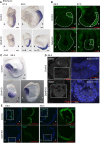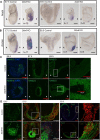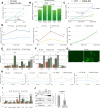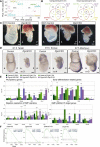The RNA helicase DDX6 controls early mouse embryogenesis by repressing aberrant inhibition of BMP signaling through miRNA-mediated gene silencing
- PMID: 36197846
- PMCID: PMC9534413
- DOI: 10.1371/journal.pgen.1009967
The RNA helicase DDX6 controls early mouse embryogenesis by repressing aberrant inhibition of BMP signaling through miRNA-mediated gene silencing
Abstract
The evolutionarily conserved RNA helicase DDX6 is a central player in post-transcriptional regulation, but its role during embryogenesis remains elusive. We here show that DDX6 enables proper cell lineage specification from pluripotent cells by analyzing Ddx6 knockout (KO) mouse embryos and employing an in vitro epiblast-like cell (EpiLC) induction system. Our study unveils that DDX6 is an important BMP signaling regulator. Deletion of Ddx6 causes the aberrant upregulation of the negative regulators of BMP signaling, which is accompanied by enhanced expression of Nodal and related genes. Ddx6 KO pluripotent cells acquire higher pluripotency with a strong inclination toward neural lineage commitment. During gastrulation, abnormally expanded Nodal and Eomes expression in the primitive streak likely promotes endoderm cell fate specification while inhibiting mesoderm differentiation. We also genetically dissected major DDX6 pathways by generating Dgcr8, Dcp2, and Eif4enif1 KO models in addition to Ddx6 KO. We found that the miRNA pathway mutant Dgcr8 KO phenocopies Ddx6 KO, indicating that DDX6 mostly works along with the miRNA pathway during early development, whereas its P-body-related functions are dispensable. Therefore, we conclude that DDX6 prevents aberrant upregulation of BMP signaling inhibitors by participating in miRNA-mediated gene silencing processes. Overall, this study delineates how DDX6 affects the development of the three primary germ layers during early mouse embryogenesis and the underlying mechanism of DDX6 function.
Conflict of interest statement
The authors have declared that no competing interests exist.
Figures







Similar articles
-
RNA Helicase DDX6 Regulates A-to-I Editing and Neuronal Differentiation in Human Cells.Int J Mol Sci. 2023 Feb 6;24(4):3197. doi: 10.3390/ijms24043197. Int J Mol Sci. 2023. PMID: 36834609 Free PMC article.
-
DDX6 post-transcriptionally down-regulates miR-143/145 expression through host gene NCR143/145 in cancer cells.Biochim Biophys Acta. 2013 Oct;1829(10):1102-10. doi: 10.1016/j.bbagrm.2013.07.010. Epub 2013 Aug 9. Biochim Biophys Acta. 2013. PMID: 23932921
-
DDX6 and its orthologs as modulators of cellular and viral RNA expression.Wiley Interdiscip Rev RNA. 2014 Sep-Oct;5(5):659-78. doi: 10.1002/wrna.1237. Epub 2014 Apr 30. Wiley Interdiscip Rev RNA. 2014. PMID: 24788243 Review.
-
The RNA Helicase DDX6 Controls Cellular Plasticity by Modulating P-Body Homeostasis.Cell Stem Cell. 2019 Nov 7;25(5):622-638.e13. doi: 10.1016/j.stem.2019.08.018. Epub 2019 Oct 3. Cell Stem Cell. 2019. PMID: 31588046 Free PMC article.
-
Eomesodermin-At Dawn of Cell Fate Decisions During Early Embryogenesis.Curr Top Dev Biol. 2017;122:93-115. doi: 10.1016/bs.ctdb.2016.09.001. Epub 2016 Oct 13. Curr Top Dev Biol. 2017. PMID: 28057273 Review.
Cited by
-
The role of DEAD- and DExH-box RNA helicases in neurodevelopmental disorders.Front Mol Neurosci. 2024 Aug 1;17:1414949. doi: 10.3389/fnmol.2024.1414949. eCollection 2024. Front Mol Neurosci. 2024. PMID: 39149612 Free PMC article. Review.
-
RNA sequestration in P-bodies sustains myeloid leukaemia.Nat Cell Biol. 2024 Oct;26(10):1745-1758. doi: 10.1038/s41556-024-01489-6. Epub 2024 Aug 21. Nat Cell Biol. 2024. PMID: 39169219 Free PMC article.
-
Unraveling the Etiology of Dilated Cardiomyopathy through Differential miRNA-mRNA Interactome.Biomolecules. 2024 Apr 27;14(5):524. doi: 10.3390/biom14050524. Biomolecules. 2024. PMID: 38785931 Free PMC article.
-
Rab3B enhances the stabilization of DDX6 to promote lung adenocarcinoma aggressiveness.Mol Med. 2024 Jun 4;30(1):75. doi: 10.1186/s10020-024-00848-1. Mol Med. 2024. PMID: 38834947 Free PMC article.
-
Perspective for Studying the Relationship of miRNAs with Transposable Elements.Curr Issues Mol Biol. 2023 Apr 5;45(4):3122-3145. doi: 10.3390/cimb45040204. Curr Issues Mol Biol. 2023. PMID: 37185728 Free PMC article.
References
Publication types
MeSH terms
Substances
LinkOut - more resources
Full Text Sources
Molecular Biology Databases
Research Materials

